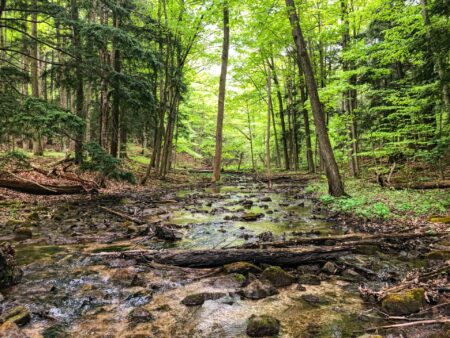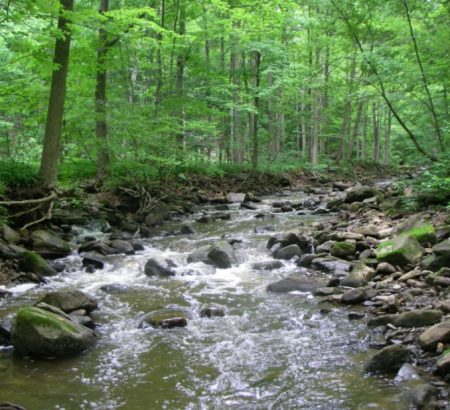The Conservation Halton watershed is made up of many natural areas, including creeks, streams, wetlands, forests, prairies and fields, as well as geological formations, that support a rich diversity of plants and animals. In addition to providing habitat for wildlife and opportunities for recreation, these natural areas support water, air and soil quality, flood, erosion and drought management, carbon storage and resilience to the impacts of climate change.

“Environmental monitoring” is an important step in the process of managing our natural resources as a conservation authority. Monitoring provides us with scientific, quantitative data about the ecological health of the natural areas in our watershed, and helps us understand how these areas and ecosystems are being impacted by change, both natural (i.e., seasons) and unnatural (i.e., climate change). Conservation Halton uses this data to make informed decisions and set appropriate goals when it comes to planning, permitting, policies, restoration and other functions of conservation.
Monitoring practices range from conventional inventories to innovative technologies, such as electrofishing, acoustic recorders, DNA analysis (to confirm “pure” species vs. “hybrid” species), motion-triggered wildlife cameras and environmental DNA (eDNA) to collect DNA in water samples.
Long-Term Environmental Monitoring Program
In 2005, Conservation Halton implemented the Long-Term Environmental Monitoring Program (LEMP). Monitoring provides important information on the health of our environment at a specific point in time, and when monitoring is continued over the long-term, we are able to observe trends. This program provides a comprehensive understanding of environmental health over an extended period of time and ensures that monitoring is completed with consistency.
Here at Conservation Halton, monitoring is completed in a five-year cycle. Each year, ecologists focus on a different grouping of watershed areas, which are monitored every year, two years or five years, depending on what is monitored in each area. At the end of the five-year cycle, Conservation Halton completes the “Watershed Report Card,” which uses the same standardized metrics as other conservation authorities throughout Ontario.
The Watershed Report Card and other monitoring results are shared with the public using interactive “story maps” that outline the location of each monitoring station, the monitoring results from each station and trends that are observed from those monitoring results.
“Biodiversity” is a term used to describe the number and variety of organisms found within a geographic region. Ecosystems that have a wide variety of plants and animals tend to be healthier and more resilient than those with less biodiversity. Biodiverse ecosystems are able to adapt more easily to natural changes, but changing conditions as a result of human activity have the potential to disrupt biodiversity and damage these ecosystems.
Humans disrupt biodiversity in four major ways:
- Habitat loss and degradation
- Increased amount of pollution
- Unsustainable use of resources
- Introduction of invasive species
Climate change exacerbates the effects of all these stressors and is itself a major source of disruption to biodiversity and ecosystems. Conservation Halton completed a report about the effects of climate change on biodiversity in September 2023.
Conservation Halton plays an important role in protecting biodiversity within the watershed by monitoring species, protecting natural areas, restoring natural habitat, creating wildlife corridors, and increasing awareness.
“Species at risk” is a designation given to plant and animal species that are threatened with extinction, extirpation, or endangerment within a geographic region.
There are four categories of risk:
- Extirpated: A native species that no longer exists in the wild in Ontario, but still exists elsewhere (e.g., Greater Prairie-Chicken)
- Endangered: A native species facing extinction or extirpation (e.g., American Chestnut tree)
- Threatened: A native species at risk of becoming endangered in Ontario (e.g., Blanding’s Turtle)
- Special Concern: A native species that is sensitive to human activities or natural events that may soon cause the species to become endangered or threatened (e.g., Monarch Butterfly).
Species can become “at risk” from a number of human influences, including changes in land use, loss of habitat, increase in pollution, and the spread of invasive species. Once a species is classified as being at risk, it is added to the Ontario Ministry of Natural Resources’ Species at Risk in Ontario List.
Here in the Conservation Halton watershed, there are a number of mammals, birds, reptiles, amphibians, fish, insects, and plants are facing threats to their survival, and many species are considered to be at risk. For many of these species, the Carolinian forests or the Niagara Escarpment, which are featured contained in the Conservation Halton watershed, is the only place that they can be found in Canada.
Ecologists at Conservation Halton monitor populations of species at risk and their habitats, so that efforts can be made to protect them. Protecting species at risk is an important element of preserving biodiversity in the watershed.
In particular, Conservation Halton often works with private and public landowners to restore habitat for and improve conditions for three aquatic species at risk:
- Redside Dace (Clinostomus elongatus)-The Redside Dace is a colourful minnow with a thick red stripe that extends half-way down the body and a thin yellow stripe that extends to the tail. It has a uniquely large up-turned mouth that allows it to feed by jumping out of the water to catch insects. It is impacted by alterations to habitat and impaired water quality typically associated with changes in the landscape.
- Silver Shiner (Notropis photogensis)- The Silver Shiner is a large minnow, silvery in colour with a dark stripe down its back and a large snout with black crescents along its nostrils. It is often found in deep pools and runs with clean gravel and rock bottoms. They are impacted by dams, alterations to habitat and impaired water quality.
- American Eel (Anguilla rostrata)- The American Eel is a long, snake-like fish with thick lips and a strong jaw. They are unique in that they spawn in the Sarcasso Sea with juveniles migrating inland where they may live a number of years. Once they mature, they return to the Sarcasso sea to spawn. They are most directly impacted by dams and barriers which inhibit their ability to migrate to feeding and spawning areas.
“Invasive species” are plants, animals or pathogens that are introduced, either intentionally or accidentally, to an area where they are non-native, and have negative environmental effects. Invasive species, which can be found in both aquatic and terrestrial ecosystems, often spread quickly because it they are able to adapt to a variety of habitat conditions and often lack the natural control of predators.
Non-native species can sometimes coexist with native species without becoming invasive but non-native species often become invasive when they overwhelm or push native species out of their habitat. Loss of native species, on both a small or large scale, can upset the natural balance of an ecosystem and reduces the biodiversity of the area. In some cases, invasive plant species can reduce biodiversity so drastically that they create a monotypic community, where the invasive is the only plant species that grows.
Conservation Halton is in the process of developing an Invasive Species Strategy. Priority species will include:
- Common Reed Grass (Phragmites)
- Dog-Strangling Vine
- Eurasian Watermilfoil
- Oak Wilt
- Periwinkle
- Spongy Moth
- Emerald Ash Borer
- Zebra Mussels
- Giant Hogweed
Although species introductions and range expansions have occurred throughout history, human activity has accelerated the long-distance transport of non-native species. Non-native plants are sometimes brought into a new area, intentionally, for ornamental purposes or for medicinal uses. Aquatic invasive species are often released to new areas in hopes of creating new fishing opportunities or releasing unwanted pets. Invasive species of plants and animals are also unintentionally transported, accidentally, on the bottoms of ships, in packing materials or through recreational activities such as fishing, boating, hiking and camping.
How can you help prevent the spread of invasive species?
- Consult an expert or do your own research to understand which species are native and invasive in your area.
- Use only native plant species for gardening and landscaping, especially in, around or near larger natural areas.
- The Ontario Invasive Plant Council has a “Grow Me Instead” Guide for Southern Ontario.
- Be careful with seed and plant mixtures! Many mixes include invasive species, so always read the label.
- Talk to your local municipality about including native species in municipal planting projects and by-laws.
- Clean dirt and plant matter from your boots and outdoor equipment before moving to a different location.
- Rinse water recreation equipment and allow to dry in the sun for five days, if possible, before moving to a new location.
- Only pick up firewood from the area in which you intend to burn it. Never transport from one location to another.
- If you see an invasive species you can report it to the Early Detection and Rapid Response Network.
- If you see an invasive species in our watershed, you can send it to Conservation Halton so we can add it to our datasets.






